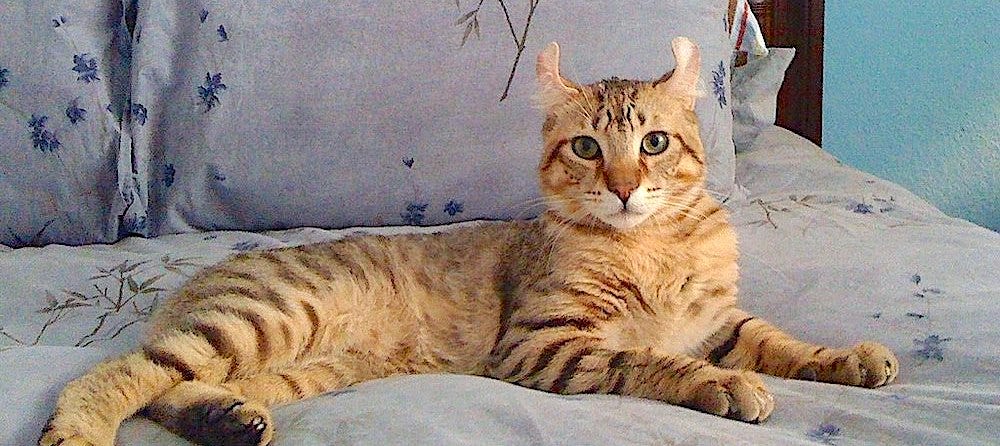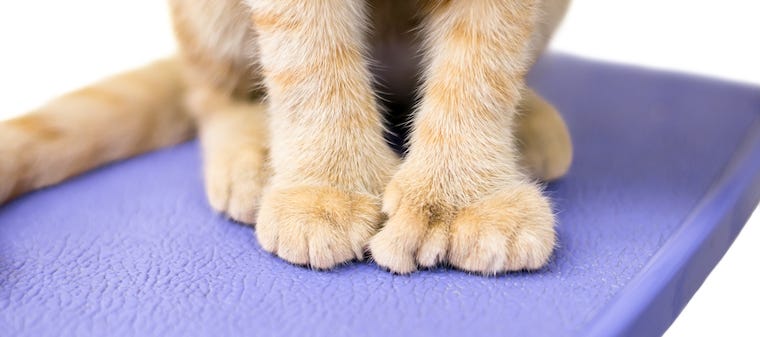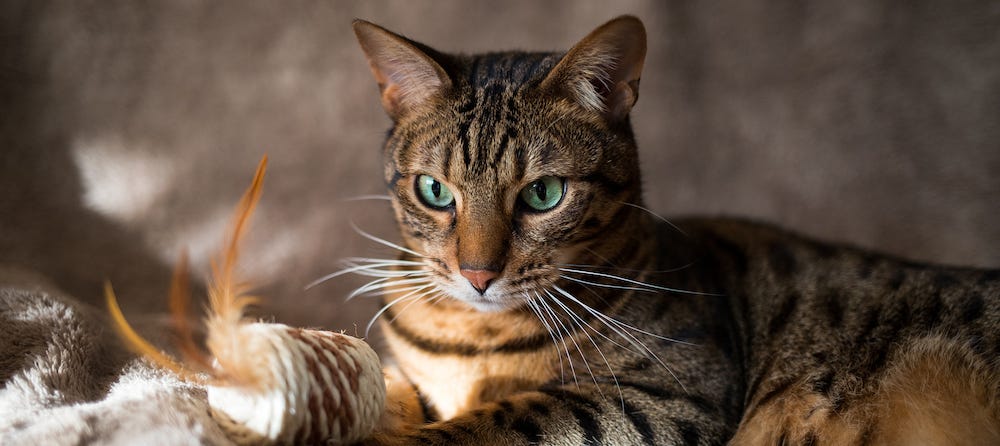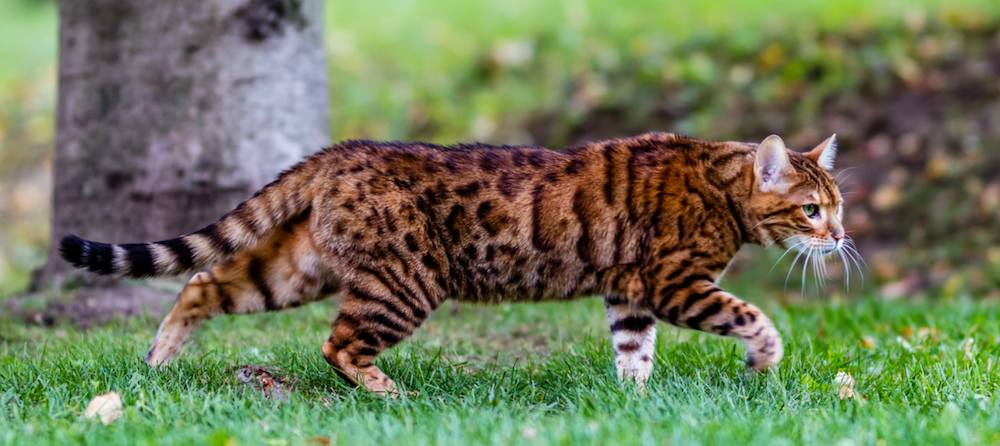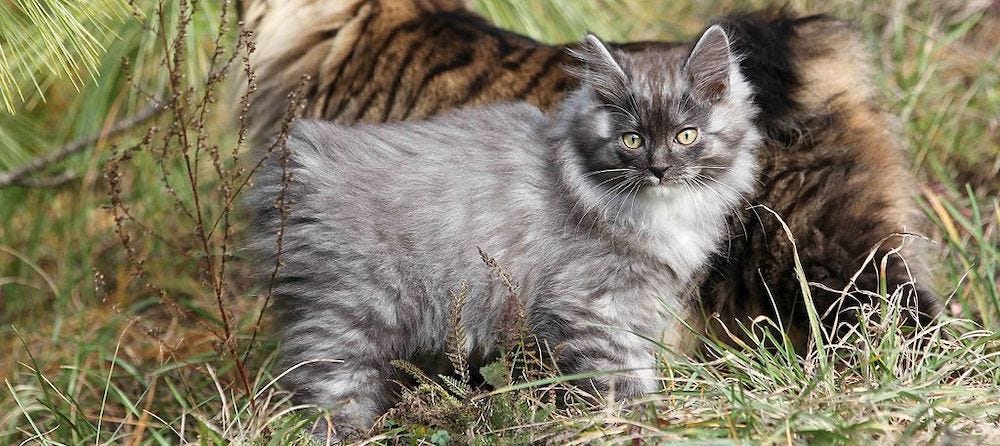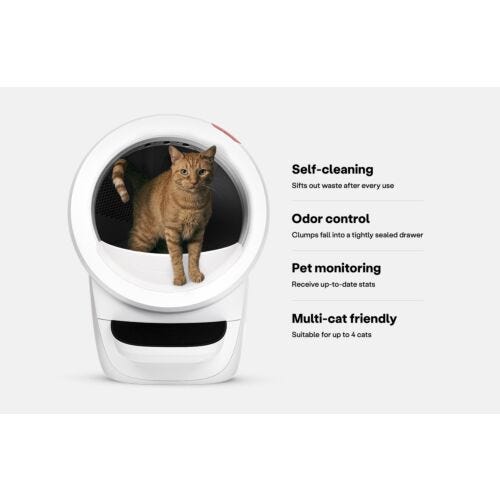The Highlander cat likely isn’t one of the first cat breeds you think of—and maybe you’ve never heard of them until now. They are rare and unique, so meeting someone who has one as a pet is not very common. However, once you learn about these cats, you may just become infatuated.
They are gorgeous wild-looking cats that will steal your heart with their loving and playful energy. Highlanders have a very distinct look that takes features from a variety of cat breeds, including curled ears, a bobbed tail, and wild markings.
To learn more about this beautiful breed, keep reading.
| Highlander cat | ...at a glance |
|---|---|
| Personality | Playful, affectionate, outgoing |
| Life expectancy | 10-15 years |
| Weight | 10-20 lbs |
| Coat & colors | Short or long; various colors & patterns |
| Energy level | High |
| Affection level | High |
| Friendliness | High |
| Shedding level | Medium |
| Required grooming | Medium |
Overview of the Highlander cat

The Highlander cat is a medium- to large-sized cat that was developed to resemble a big cat. We all love the thought of being a parent to an exotic cat, but not the reality of what that would bring. With the Highlander, you’ll undoubtedly find your neighbors mistaking your cat for a wild cat… until they meet them, that is.
Weight
The Highlander cat is one of the larger domestic cat breeds. They typically weigh 10 to 20 pounds, with males slightly larger than females. When provided plenty of opportunities for exercise and a well-balanced diet, your Highlander can maintain a healthy weight without much help.
They have bobbed tails that may make them seem smaller than they are, but their dense coat makes up for it.
Length
Despite the fact that the Highlander cat has a bobbed tail, they can grow up to 22 inches long. They are lengthy, muscular cats that appear proportional, all things considered (like their tiny tail).
Coat
A Highlander cat's coat can either be short or long. Their fur can grow up to 2.5 inches in length. This breed can display a variety of colors and patterns, including solid, tabby, smoke, and tortie. No matter what your Highlander’s coat looks like, you will love running your fingers through it!
Life expectancy
A Highlander will typically live 10 to 15 years. With a proper diet, exercise and stimulation, regular veterinarian appointments, and a life indoors, your Highlander can live a very rich life in your care.
History of the Highlander cat

The Highlander is one of the newest breeds of cat, having been developed in the 1990s. A breeder named Joe Childress from the United States wanted to create a new breed that would resemble big cats. Childress crossed a Desert Lynx and a Jungle Curl together to get what was first named the Highlander Lynx. Unfortunately, this cat was not recognized by any cat registries.
Eventually, the “Lynx” was dropped from the name, and the cat became known as the Highlander. They are still not recognized by major cat registries, but they are with the Rare and Exotic Feline Registry. Even though they are not recognized as a breed by everyone, that doesn’t make them any less of a beautiful and deserving cat!
Characteristics of the Highlander cat
Highlander cats are larger than the average domestic cat breed. They have muscular bodies that appear rectangular in shape. They have a straight back with hips that are higher than their shoulders, giving them a slight slope.
Highlanders are most recognized by their curled ears and bobbed tails. These two features are why this breed appears so wild-looking, as many might assume they’re looking at a wild Lynx. However, some Highlanders are born with straight ears, a long tail, and polydactyl feet (extra toes).
Highlanders have rather thick bodies, with large, inverted, pear-shaped heads, a squared muzzle, and a wide nose. Their ears are medium in size, with a wide, firm base and flexible tips that curl up to 90 degrees.
Long-haired Highlanders will likely have tufts of fur in between their toes and on their ears. This breed can display various eye colors and coat colors, so you never truly know what you’re getting until you see one in person.
Personality and behavior

The Highlander has been frequently compared to a dog in how they behave. They are incredibly playful and outgoing, and love to meet new people. With their wild looks, you might be surprised by how people-oriented they are.
Highlanders can make great friends with other cats and dogs as long as they are introduced properly. Their friendly and playful manner also makes them a good match for children. However, ensuring children know how to properly interact with cats is paramount.
Playful and energetic
Highlanders have plenty of energy that they need to burn daily. They are naturally active and tend to exercise enough independently, but they appreciate interactive play with their humans. Providing a collection of toys around the house (refreshed from time to time) that you can pick up and engage your Highlander in will keep them occupied.
Highlanders love to climb and explore, but it’s better to let them do so indoors rather than outside. Having several cat trees for climbing, shelves for perching, and a cozy spot for bird- and squirrel-watching will help entertain a Highlander.
You might also want to invest in scratching posts because Highlanders like to scratch. This will be beneficial to both their nail length and your furniture!
Caring for a Highlander cat

Highlander cats are a high-energy breed that can be a bit high maintenance. When you adopt a Highlander, be prepared for an active cat who wants a lot of attention. They are driven and loving, making them a great companion. However, working on training them and developing a bond only makes the relationship that much better.
Highlanders are intelligent and can learn how to play fetch and walk on a leash. Both of these activities can help keep your Highlander occupied and entertained. Fetch is both interactive and fun, making it an easy activity to do with your cat throughout the day.
If you choose to teach your Highlander how to walk on a leash, you can let them explore their wild side by spending time enjoying the outdoors in a safe manner. Coming up with new activities and puzzles for them is one way to keep their intelligent mind content!
Grooming
Highlanders can have both short or long coats, so their grooming regime varies. Regardless of length, you will want to brush your Highlander’s coat a few times a week to help remove any loose hair. You can use a soft slicker brush for this.
Long-haired Highlanders might need to be brushed more frequently. Pay particular attention to their shaggy belly hair—this area is more likely to become matted, so brushing it every few days can avoid this issue.
Be sure to trim their nails once or twice a month, and make sure their ears stay nice and clean. Keeping up with their dental care can also reduce the risk of periodontal disease.
Ensure your Highlander’s litter box is always clean for them. You can make this job easier by using a self-cleaning litter box. This way, you don't have to worry about scooping either.
Health-related issues
The Highlander is thought to be a relatively healthy cat, but with more research and understanding of the new breed emerging, we might get a clearer picture. As of now, there are no known breed-specific health issues that the Highlander has.
Due to the curl of their ears, they might be more prone to ear infections; keeping their ears clean can avoid that. Ask your veterinarian how often your cat will need their ears cleaned.
Loving a Highlander at home
The Highlander is a precious cat to have in your family, and you’d be lucky to bring one home. If you are looking for a loyal feline that will shock everyone with their unique look, the Highlander should be on your list. These gorgeous cats are wonderful pets to love and even more wonderful cats to be loved by.
Sources:
- Genetic Epidemiology Of Blood Type, Disease And Trait Variants, And Genome-Wide Genetic Diversity In Over 11,000 Domestic Cats | PLOS Genetics
- Compatibility Of Cats With Children In The Family | Frontiers
- Periodontal Disease In Cats: Back To Basics--With An Eye On The Future | NCBI
- Instructions for Ear Cleaning and Administering Ear Medication in Cats | VCA Animal Hospital
- Indoor Cats vs. Outdoor Cats | American Humane
Photo credits:
- © TAnthony / CC-BY-SA-4.0
- © Christina Hall / CC-BY-SA-4.0
- © DigitalDirt / CC-BY-SA-4.0
